Ammonium nitrate explosion in Beirut kills at least 135 people

AN explosion at a warehouse storing ammonium nitrate in Beirut, Lebanon, has killed at least 135 people and injured at least 5,000.
Two explosions occurred at around 18:00 local time on 4 August. According to local media and video footage, the initial explosion caused white smoke to rise from the warehouse in Beirut port, followed by a huge second explosion which sent a shockwave out from the blast site. A pillar of reddish-brown smoke was seen rising from the site, the colour being characteristic of nitrogen dioxide. A video from The Guardian shows the devastating nature of the blast.
The shockwave shattered windows and damaged buildings several kilometres away from the blast site. Rescuers are still reportedly searching through the rubble for missing people. Hospitals across the city – reported by the BBC as already struggling to cope with Covid-19 – are overwhelmed, according to Reuters. The New York Times reported that one hospital was so badly damaged by the blast that it had to shut down and send patients elsewhere.
According to BBC, Lebanon’s President Michel Aoun said that 2,750 t of ammonium nitrate had been stored at a warehouse in the port since 2014 without any safety measures in place. The ammonium nitrate had been impounded from a ship that brought it into the port in 2013.
An anonymous source familiar with the situation at the port told Reuters that the storage issue had been brought to the attention of “several committees and judges” but that nothing was done. The person reported that a fire started in warehouse 9 at the port before spreading to warehouse 12, which housed the ammonium nitrate. A second source told Reuters that a team that inspected the site six months ago warned that it could “blow up all of Beirut”. According to Reuters, the head of the port and the head of customs had asked the judiciary to remove the material.
Ammonium nitrate is primarily used for fertiliser. It is not explosive by itself but can cause explosions under certain conditions. Ken Patterson, Editorial Panel member of the IChemE’s Loss Prevention Bulletin, said: “Ammonium nitrate requires a significant igniter. The video evidence in Beirut showing the fire before the explosion, with fireworks apparently exploding all the time, would have provided an obvious source of ignition for the ammonium nitrate store.”
Geoffrey Maitland FIChemE, Professor of Energy Engineering, Department of Chemical Engineering, Imperial College London, said: “If it [ammonium nitrate] comes into contact with an intense source of heat and ignition, such as a detonator or an intense fire for some time, and is present as a large bulk mass (eg confined within containers or sacks, which may themselves be flammable) and in a confined space, such as a warehouse, then it can explode. It decomposes rapidly to gases, and because of the confinement, heat cannot escape, the gases rapidly expand, and the explosion occurs. This releases an enormous amount of energy, and sends out a shock wave as the surrounding air is rapidly compressed, which propagates very rapidly over the surrounding area and does enormous damage to buildings and people. This is what seems to have happened in Beirut yesterday.”
Maitland said that the long-term storage of the ammonium nitrate could also have made it susceptible to explosion. “For instance, if the storage was not airtight, in the humid conditions of Beirut, the salt could have taken up large quantities of water from the air which would cause the granules and pellets to fuse over time into a large consolidated mass from which heat and gases from the decomposition could not escape as easily as from a dispersed granular, free-flowing pile of fine particles. This would have just added to the confinement effect which increased the risk of an explosion once a source of heat was applied.”
The dangers of ammonium nitrate storage have long been known. Numerous catastrophic explosions relating to ammonium nitrate have occurred throughout the last 100 years, as detailed in a Loss Prevention Bulletin article by Zsuzsanna Gyenes, Deputy to the Director, IChemE Safety Centre, and Nicolas Dechy from IRSN. These include a blast at a BASF plant in Germany in 1921, which killed 507 people and left a crater 20 m deep, and the Texas City disaster in 1947 when two ships carrying ammonium nitrate and sulfur exploded, killing 500 people. Another ammonium nitrate explosion occurred in Texas in 2013 at the West Fertiliser Company which killed 15 people. The AZF site in Toulouse exploded in 2001, killing 30 and injuring around 10,000 people.
Trish Kerin, Director of the IChemE Safety Centre, said: “Tragically we have seen a massive explosion in Beirut, but even worse is that this is the latest in a long list of ammonium nitrate explosions that have occurred around the world. We must do better to learn the lessons of the past, those lessons are written in blood. This incident reminds us of the importance of process safety in our workplaces, including storage facilities. We must implement and manage the controls to prevent and mitigate the consequences.”
An updated version of this article appeared in the September edition of the magazine.
Recent Editions
Catch up on the latest news, views and jobs from The Chemical Engineer. Below are the four latest issues. View a wider selection of the archive from within the Magazine section of this site.




